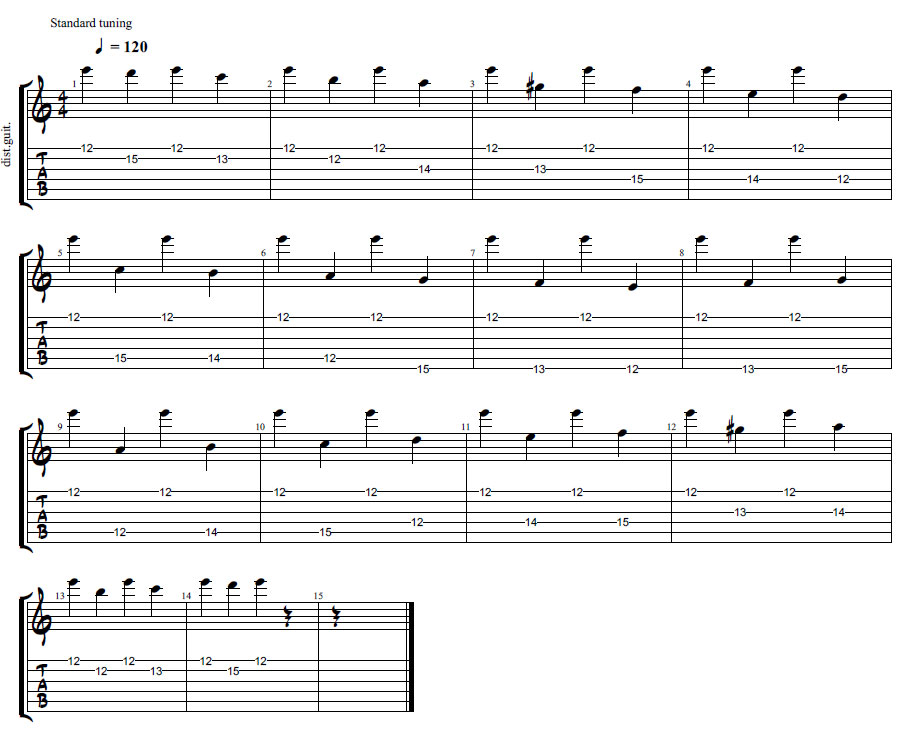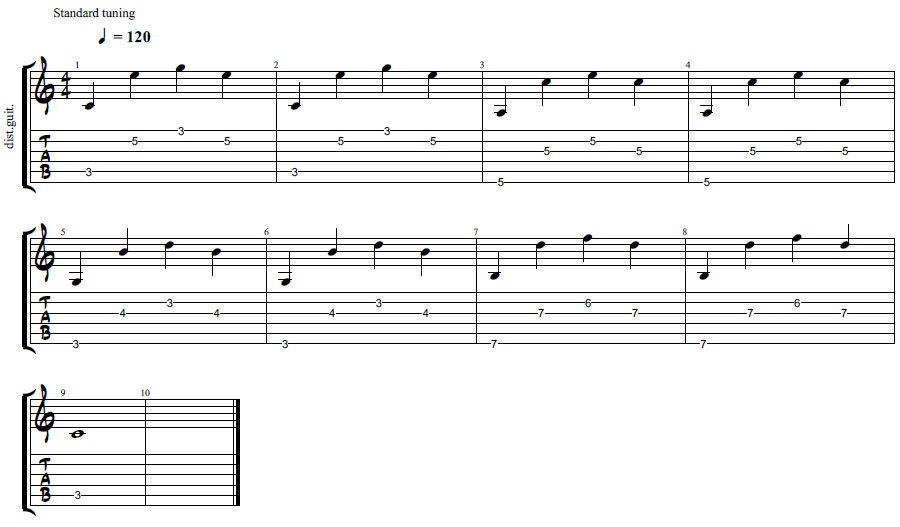String Skipping Basics
How To Add Wide Intervals To Your Lead Sound
When playing guitar, we often try to keep our movements to the same or adjacent strings for maximum speed and efficiency. However, this can be limiting on the notes and intervals we can play. By skipping strings, we get more intervals, thus more melodic choices and variations in our picking.
What is string skipping?
By making larger jumps across the strings, we can do what other instruments can. A piano or sax can easily make a large interval note jump, to do that on the guitar we have to move our fingers farther than normal.
On the guitar we usually follow melodies in a linear motion, but we have limited note movement when staying in the same area. Instead of moving far down or up the fretboard to hit a further note, it is more efficient to jump strings. This will increase the notes in the scale and size of the arpeggios we can play.
Now instead of playing in the normal triad range of thirds and fifths, we can skip strings and play sixths, sevenths, and octaves. The skipping will also spread our voices out and help in playing inversions through different octaves. Sometimes we just jump over one string, other times multiple ones and that can get difficult!
Often you will not be skipping after every note, normally we play a few legato notes on each string and then make the jump. In some genres of music like classical and metal, the skipping is needed to get all the necessary notes. But it is also a technique used in bluegrass, jazz, and all the varieties of fusion guitar playing out there.
String Skipping Exercises
Exercise 1
Your first string skipping exercise uses the A minor pentatonic

Exercise 2
This exercise is based on the G major scale in 3-notes-per-string fingering.

Exercise 3
This exercise uses the E at the 12th fret of the E high string as a pedal note and go down and back with a neoclassical flavour.

Exercise 4
This exercise shows you how to apply string skipping to open triads and get a nice effect.

How do you skip strings?
Before you can start string skipping you have to be familiar with the basic flatpicking technique. Most guitarists at this level have a decent amount of experience in it, but the better your techniques are the less you will have to worry about your picking hand. As for the fretting hand, making large movements comes at a price
As you can guess this technique requires accuracy, after a large movement you need to be sure your finger lands on just the right spot. That is where most of your practice time will be used, building muscle memory of these string jumps that way you always hit the same place. If you rush your practice in the early stages, you will not have the precision to speed up!
While skipping strings is not a complicated topic, in practice you run the risk of missing the non-adjacent string on an errant note. It is also important to fret and mute strings at the same time as your other hand is perfectly picking the correct strings. To get the sound and flow right you need all these factors working seamlessly.
Execution Tips
As always with guitar fretting techniques, we want to keep our fingers spaced out, one per fret. Most hand exercises will show you which finger to use, follow what it says and start as slow as you need to get it right, after you successfully are fretting the correct notes you can start playing faster.
Another reason your fretting muscle memory is important is that you will need to watch your picking hand so that you can make the jump across strings.
Start with easy exercises that you can memorize, that way you can spend some time just watching that picking hand hit the right string every time.
Classical études, or short compositions, are some of the best exercises to practice this with. Even if you are playing a metal or fusion genre, these classical works are perfect for the guitar player learning to skip strings.
You will be mixing other techniques in with your string skipping like hammer-ons, pull-offs, slides, bends, tapping, and more. It is the same arsenal of guitar tricks that you always use, just here you have more notes and intervals to choose from in the melody. Be sure to add these techniques in while playing exercises.
Notable players That use String Skipping
There are many great guitarists out there that employ the use of string skipping. Especially since it wasn't a technique invented for new styles, but one originally used to adapt older music that would not usually work with regular guitar playing. A larger interval was necessary and so players had to adapt!
- Steve Morse of Deep Purple was one of the early influencers on songs like this that have a very classical vibe to them.
- And Paul Gilbert is phenomenal at playing pure classical pieces. Remember he is playing notes that were written for keyboards and pianos!
- Paul Gilbert also plays with Bruce Bouillet, another master of the jump. And here that same band Racer X is playing harmonized string skipping.
- Of course we can't forget Brendon Small and the cartoon Metalocalypse, which has tons of songs with great picking examples for heavy metal.
- If you prefer more jazz styles, John Scofield uses this picking in his playing.
- And you don't always have to stay in complicated jazz and metal, pop doesn't require difficult string skipping but it uses it on occasion in songs like "Spiderwebs" by No Doubt
- "Street Spirit" by Radiohead. They both have decent beginner skipping parts.
- One of the most popular examples of string skipping is the 80's hit "Sweet Child o' Mine". It was originally used as a warmup exercise and was incorporated into the song. The jumps in this aren't that difficult so it makes a great beginner riff to practice on with nice sweeping arpeggios.
There are so many great examples of string skipping in the past 50 years you will never have to look far!
Conclusion
String skipping is a great way to build dexterity and coordination, and like other soloing techniques it can add a smooth and fluid final sound to the piece. However, to get there you have to memorize all the movements of your fretting hand and master the art of picking non-adjacent strings perfectly.
It is a very simple process that will take lots of practice and dedication!
If you want to stay updated (and get free chords and scales pdf, subscribe here)